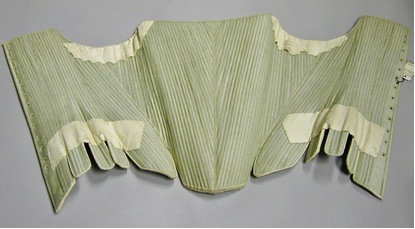Corset
UK, 18th century
 Purchased for the Museum in 1930; 1930.84.2During the 1500s innovations in tailoring as well as textile discoveries and imports gave rise to a defined female silhouette that replaced the simple frocks of earlier centuries. The corset was a piece of underwear worn to compress and elongate the torso to enable women to squeeze in to the new shape of bodice. They were laced tight and sometimes reinforced with wooden planks, or even iron 'busks', to maintain the stiff, erect shape.
Purchased for the Museum in 1930; 1930.84.2During the 1500s innovations in tailoring as well as textile discoveries and imports gave rise to a defined female silhouette that replaced the simple frocks of earlier centuries. The corset was a piece of underwear worn to compress and elongate the torso to enable women to squeeze in to the new shape of bodice. They were laced tight and sometimes reinforced with wooden planks, or even iron 'busks', to maintain the stiff, erect shape.
By the 17th and 18th centuries corsets had become even tighter but the bust was at last permitted to escape as necklines were lowered, and whalebone or reeds replaced the iron reinforcements. This cotton-lined pale green and cream corset, from Eynsham in Oxfordshire, probably dates to the end of this period. It was made to fit its wearer (there are no lacings) and its back clasps suggest it was probably worn with court dress (as it would need a maid to help fasten it from behind).
The corset was temporarily abandoned at the end of the 18th century in favour of empire-line dresses such as those worn by Empress Joséphine. However, this trend soon passed and the corset returned as a longer garment, which cinched the waist tighter than ever whilst also emphasizing the hips. This gave rise to the 'hourglass' figure that demanded a wasp-waist measuring no more than 21 inches. The corset's extreme restraint had a moral as well as a physical dimension; it directed its wearer to act in a reserved, ladylike and 'straight-laced' manner. A female lacking in morals, and therefore lacking the correct undergarments, was referred to a 'loose woman'.
There was a price to pay for the long-term use of tight-laced corsets. They could lead to permanently deformed ribcages; internal organs could be misplaced or punctured by broken ribs; and many women suffered from breathing and digestive problems. Some women miscarried or were unable to breast-feed. Many women died. Yet the corset endured throughout the 19th century partly, it has been argued, because it signified the wealth and leisure of rich women. This was apparent to contemporary social scientists such as Thorstein Veblen who wrote in 1899 (when some activist women were already abandoning the corset):
"the corset is employed only within certain fairly-well defined social strata. The women of the poorer classes...do not habitually use it, except as a holiday luxury. The corset continues in use wherever and so long as it serves its purpose as an evidence of honorific leisure by arguing physical disability of the wearer. The gain [is] in the reputability which comes from her visibly increased expensiveness and infirmity."
The extreme 'S-bend' corset of the Edwardian era was to be the final farewell of the corset in European and American mainstream fashion. The Paris couturier Paul Poiret took steps to free women from corsets in his designs from 1908 onwards and the Paris Chamber of Commerce was so alarmed about the potential damage to the corset industry that he was begged to reverse the trend he had set. Poiret refused and events that followed, such as female suffrage and the First World War, spelt the end of the corset. Modern corsets, which mimic authentic corsets by the use of lacing or boning, are designed to enhance rather than alter the wearer's body shape.
